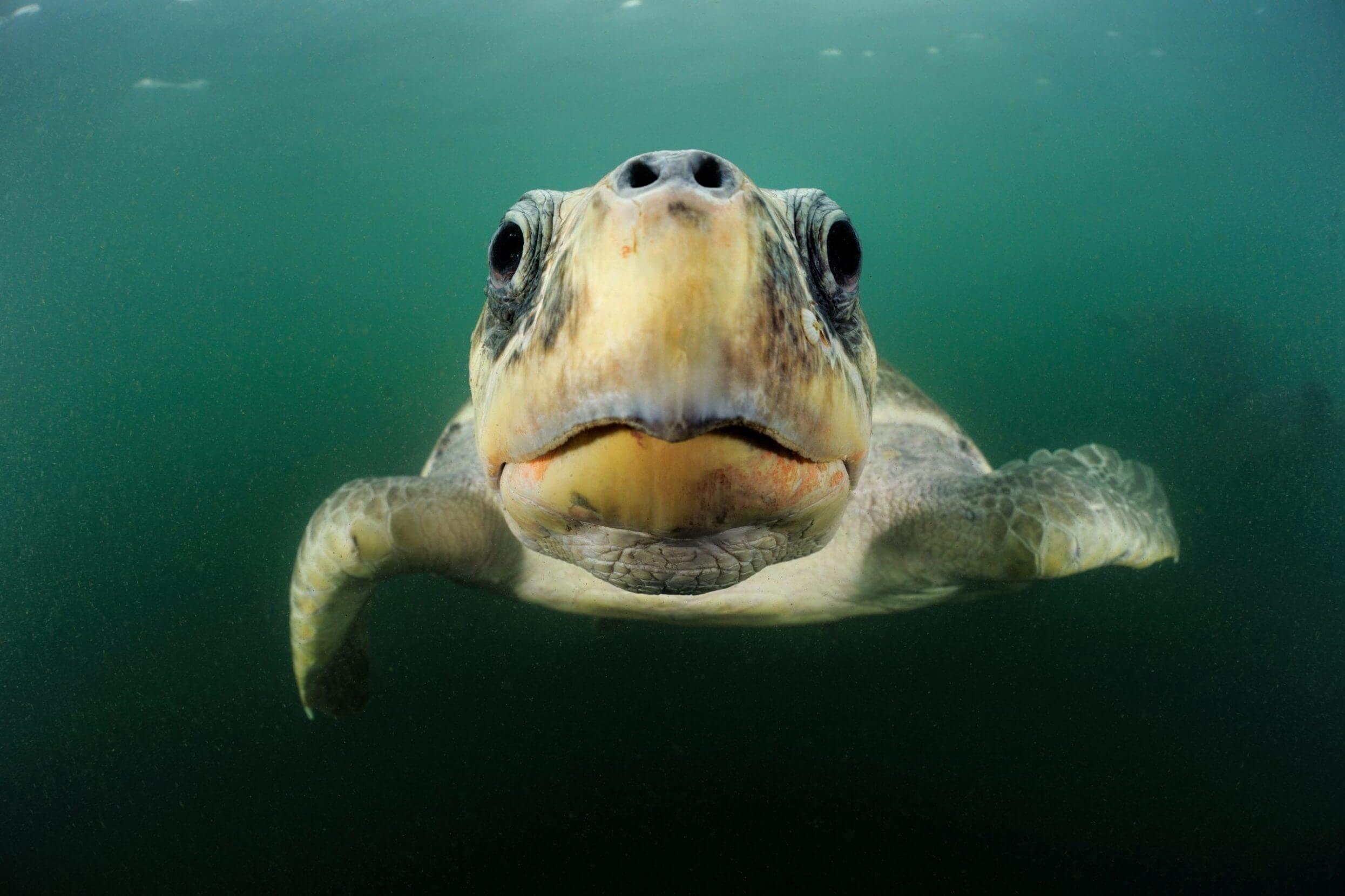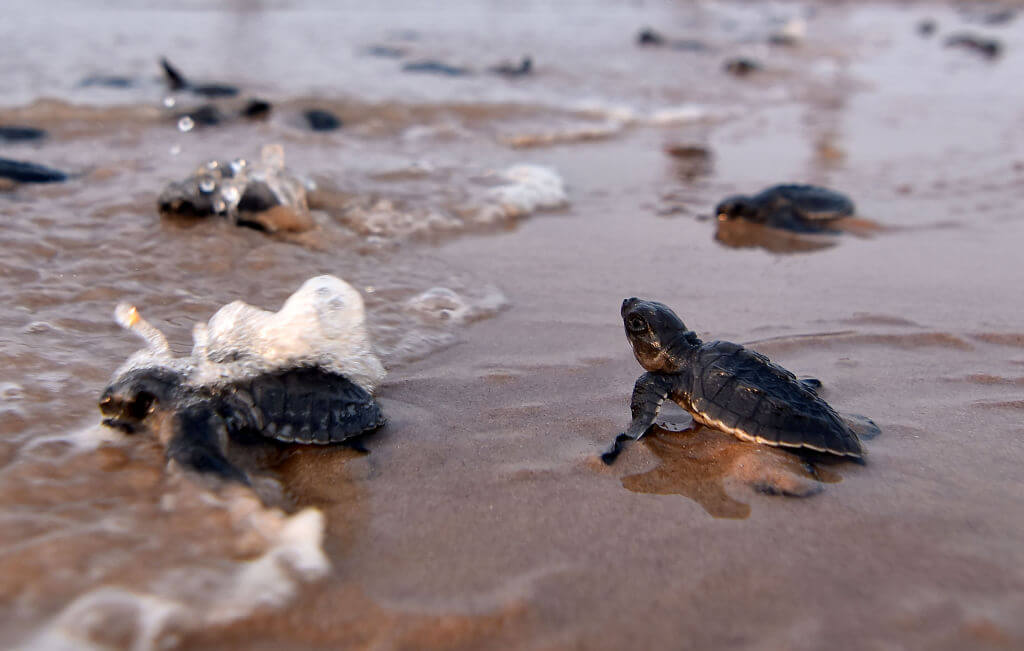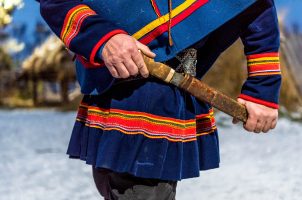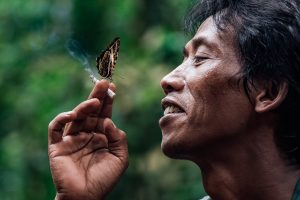Support Hidden Compass
Our articles are crafted by humans (not generative AI). Support Team Human with a contribution!
Every night is a carnival at Elliot’s Beach in Chennai, India. Rows of food stalls lead from the road towards the water’s edge. They peddle corn on the cob roasted over open fires, potatoes that are yanked into foot-long spirals and deep-fried, spicy groundnut salads, and ice cream in iridescent shades. There are carousels and Ferris wheels and an enterprising young man asking passersby to shoot an air gun at a rectangular board pinned with tiny balloons.
Past the crowds, on the sand, people squeal as ocean waves lap at their feet, ankles, and knees. Occasionally, a wave takes them by surprise and they walk home laughing about the salty, gritty clothes clinging to their skin.

Corn is cooked over open flames on the beaches of Chennai, India. PHOTO: JAMES DEV JOHN / ALAMY.
Thousands of people visit Elliot’s Beach every evening. Some of them come for the cool sea breeze, some to socialize, others for the food, or to bring their children out to play. In a metropolis of nine million people, the beaches are overrun. But humans aren’t the only visitors.
For a few months every year, between December and March, nighttime visitors from the deep swim out of the darker, quieter waters of the ocean and lumber through the sand. They’re on a mission — one that has remained unchanged for 100 million years.
~~
Olive ridleys are among the smallest marine turtles, yet their ancestors survived the forces that brought about the extinction of the dinosaurs. They can reach weights of up to 100 pounds and sport two-foot shells. Their flippers aren’t meant for moving on land or digging through gritty sand, but they do both. Female turtles lurch forward, pushing and pulling their bodies toward dry sand. They dig nests in the darkness and lay soft, pliant eggs — the eggs will harden only after they are in the nest. Eventually, the mothers return to the ocean. They’ll never know if their hatchlings make it to adulthood.

For a few months every year, Lepidochelys olivacea turtles like this one, swim from the open ocean towards the shore in Chennai to nest. PHOTO: NATURE PICTURE LIBRARY / ALAMY.
~~
The journey of the eggs and hatchlings is punctuated by threats: Feral dogs, already present up and down India’s coasts, scavenge in the rubbish of food stalls. Turtle eggs are a delightful addition to their diet. The eggs can get trampled or poached. The hatchlings, if they do emerge, might mistake the bright city lights for moonlight on the water and walk away from the ocean. And even the ones that do make it to the water still have to sidestep the threats of the sea to survive — predators, fishing nets, and plastic, to name a few.
But dogs and poachers and predators aren’t the only ones looking for the turtles. Because despite the overwhelming odds against them, the olive ridleys come every year — some of them reaching the very beach where they themselves hatched — and so, for the last 32 years, volunteers from the Students’ Sea Turtle Conservation Network (SSTCN) have been there to greet them.
~~
A group of volunteers, many of them students, walk a stretch of seashore. It is nighttime on Neelankarai Beach and the four-and-a-half-mile walk is just beginning. Some members of the group are in college and probably have class in the morning, others will have to go to work, but they ignore the late hour and forgo sleep. Instead they look for the telltale signs of a turtle having come ashore. They follow the tracks made by the flippers and dragging bodies, bending and crouching as they poke short sticks gently into the sand to look for subterranean nests. If they’re lucky, they might even witness a live nesting — a turtle still laying her eggs. However they come upon a nest, when they find one, they carefully record its shape and the relative positions of the eggs. Then, they collect the eggs — around 120 per nest — delicately by hand, preparing them to be moved to the hatchery. There, volunteers will hand dig replica nests, trying to recreate the exact conditions and facilitate safe incubation.
When the eggs hatch in a month-and-a-half’s time, the hatchlings will be released on the beach so that they can scramble to the sea.
Every night during nesting season, volunteers will walk the coast, often until 5, 6, 7 a.m. It is exhausting work, but it has its rewards.
~~
Arun is a school teacher with long black hair that he used to pull back into a low ponytail. He began working with the Network when he was 28 years old, and he laughs when he says that he was the oldest member back then because that was 23 years ago. Now, after coordinating the work of the SSTCN for nearly a quarter century, he is still hooked.
“In a single season,” he says, “You rescue the eggs, see them hatch after 45 days, and release the hatchlings into the sea. It is a phenomenal thrill.”
Despite the overwhelming odds against them, the olive ridleys come every year … and so, for the last 32 years, volunteers from the Students’ Sea Turtle Conservation Network have been there to greet them.
But conserving turtles can seem like a luxury in a developing economy. When the income from a single food stall on the beach is feeding, clothing, and housing an entire family, olive ridleys can become a distant consideration. Arun acknowledges this reality but he is also hopeful:
“Chennai is a city of, what, eight to nine million people? Is it really that hard to find volunteers to work with such an ancient species?” he asks.
The Network started out believing that they were saving olive ridleys from extinction. “Initially, there was a heroic zeal about the work,” Arun says. Thirty years ago, very little was known about olive ridleys in the subcontinent. Even large-scale, synchronized nestings in Gahirmatha, 870 miles to the north, were just beginning to draw the attention of scientists and conservationists.
Over time, though, it was tough to ignore the fact that India has nearly 4,700 miles of coastline, and the SSTCN was only patrolling about one tenth of one percent of it.
“We can’t change much about olive ridley populations in the ocean,” says Arun. He has been dedicated to the cause for almost half of his life, but he is also pragmatic.
~~
Kartik Shanker is a tall man with a salt and pepper beard and a big smile. “I just turned 50,” he says, “A bit balder, but no wiser.”
Thirty years ago, he was a college student when he became one of the founding members of the SSTCN. Today he is an ecologist at the Indian Institute of Science in Bangalore, working toward biodiversity conservation. In his book, From Soup to Superstar, about the olive ridley conservation movement in India, he suggests that the turtles have influenced generations of Indian ecologists and conservationists like himself. People like Dr. Abi Vanak, for instance, began their careers with the Network. In Vanak’s case, he volunteered with the group for seven years — from high school until the end of college.
“I was already interested in wildlife studies,” says Vanak, “And SSTCN gave me an excellent opportunity to start hands-on work with animals from a very early stage.”
His work with the group and understanding of these marine creatures helped him find a spot in a prestigious graduate program at the Wildlife Institute of India (WII).
“I received a fairly thorough grilling from the resident turtle expert at WII,” says Vanak.
Now his research covers a vast range of topics – from invasive species to disease ecology to wildlife in human-dominated systems. But he has fond memories of his time with the olive ridleys and their hatchlings.
“The experience I had with the SSTCN will remain the most memorable part of my early forays in to wildlife conservation,” says Vanak. He hopes to take his children on a turtle walk in Chennai sometime soon.
There are others, too. Adhith Swaminathan took his first turtle walk when he was 10 years old and went on to work with leatherback turtles, the largest species of marine turtle. Divya Karnad, who took her first turtle walk in college, went on to study the impact of light on olive ridley turtles in the Indian state of Orissa (now Odisha). And Joseph Raja, who took his first walk at 15, abandoned plans to study commerce in school and instead became a wildlife filmmaker and photographer.
Some, like Akila Balu, who took her first walk in college, went on to found other conservation organizations, but stayed involved with the SSTCN. She has been coordinating turtle walks since 2008.
“She is the backbone of the group now,” says Arun, “and in many ways more important than me.”
But the turtles don’t just turn volunteers into conservationists. For years, the state government included the Network’s efforts in school textbooks, and had a lesson about olive ridley conservation in the region.
“Earlier, we were often stopped by suspicious policemen,” says Arun. The volunteers were, after all, walking through deserted beaches, late at night. But now there’s a new generation of policemen who grew up reading about the SSTCN. The awareness has made them more sensitive to the work done by the volunteers, and they often watch over the beaches, helping to protect the eggs and the turtles.
And in 2016, it was the local fishermen who told Arun that they were spotting dead turtles in the ocean that would soon wash ashore. They were right. That season, the volunteers found 85 dead adult turtles during their patrols.
Beach usage has changed vastly over the past couple of decades. Twenty years ago, the beaches of Chennai were deserted by 10 p.m. Today, changing lifestyles and a rise in shift work equal throngs of people at all hours — people who bring artificial light and trash, and ride all-terrain vehicles across the sand.

Over the last two decades, crowds have grown at Chennai’s beaches, threatening the turtles and their conservation. PHOTO: PAUL KENNEDY / ALAMY.
The past worries about poachers, which were the biggest threat to the eggs until 1995, have been replaced by worries about the impact of the buildings, resorts, and clubs cropping up along the water’s edge.
“Most are in violation of existing coastal management zone laws,” Arun says, pointing towards the institutional corruption that allows these structures to get building permits.
There are additional challenges as well.
“If we were in a safe space, we could have trebled our volunteer count,” says Arun, who adds that he cannot send women alone at night to look for turtle eggs. “They work primarily in the hatchery.”
But people still want to feel a stronger connection with nature. They want to understand the complex relationship between the human and animal worlds. And so, in spite of the challenges, the Network continues to attract volunteers.
Over 32 years, SSTCN volunteers have rescued nearly half a million eggs and released more than 300,000 hatchlings into the sea.

Each year, millions of olive ridleys hatch on India’s beaches. PHOTO: ASIT KUMAR / AFP / GETTY IMAGES.
They’ll never know if the hatchlings make it to adulthood, or if their work is having an impact on olive ridley populations, but still they come.
And these turtles that swim ashore every year to lay their eggs on the beaches of Chennai — they, too, will never know if their hatchlings make it to adulthood. They will never know that they’ve inspired generations of conservationists.
But still they come.
Yasaswini Sampathkumar
Yasaswini Sampathkumar is a writer and recovering scientist who's learning to be as sustainable as her grandmother.



